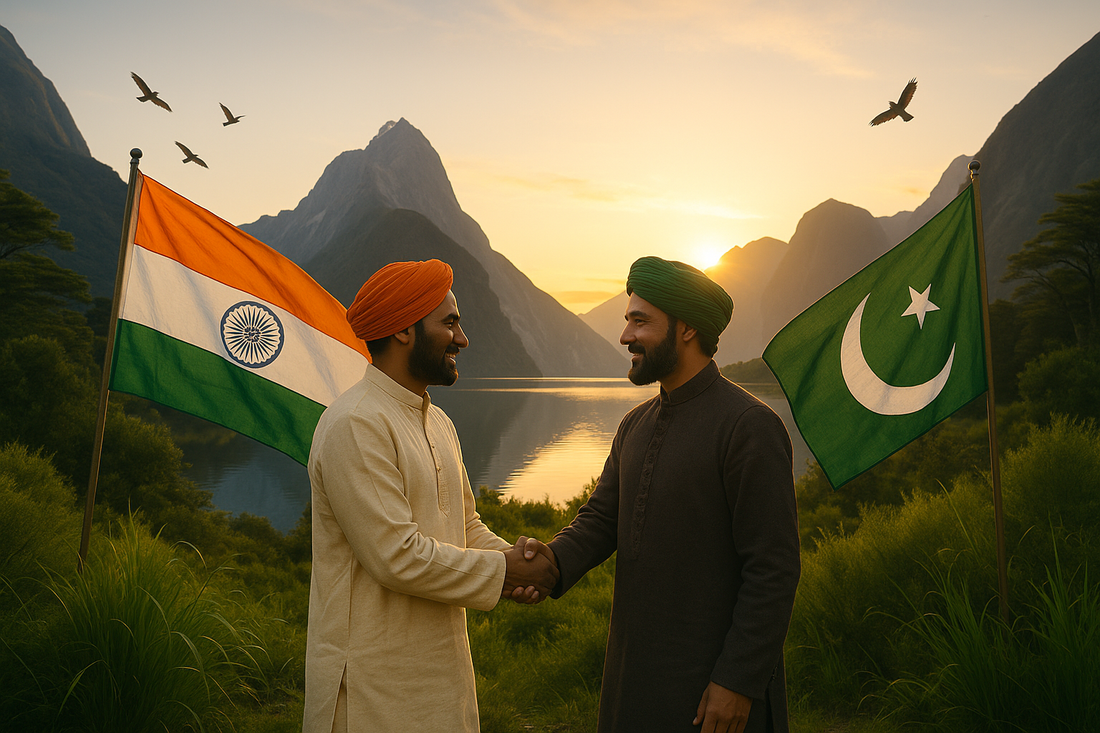
Echoes from Antiquity, Hopes for Today: Weaving Peace Between India 🇮🇳 & Pakistan 🇵🇰
Share
Hey everyone, Mani here
The world feels particularly fragile right now, doesn't it? The recent escalations and rhetoric between India and Pakistan weigh heavily on my heart, as I know they do for many of you. It's moments like these when the noise of conflict threatens to shatter the delicate silences where peace might otherwise take root. Here, on NatureBoyMani.com, we often turn to the wild expanses of nature to find solace, to remember the interconnectedness of all things. Today, I want to reach a little further back, into the deep well of ancient Indian wisdom, to find echoes that can guide our hopes for a more harmonious present.
My creative spirit has always been fueled by the dance between heritage and modernity, the intricate patterns of tradition woven into the bold fabric of contemporary life. It’s about seeing the timeless in the timely. And the call for peace, for understanding, for recognizing our shared humanity? That’s as timeless as the mountains and rivers we cherish.
It’s easy to feel small when geopolitical storms are raging. But I truly believe that the seeds of peace are sown in individual hearts and minds. And sometimes, looking back at the wisdom of those who came before us can illuminate the path forward. Ancient Indian culture, a tapestry rich with profound philosophical insights, offers us some powerful reminders:
1. The World is One Family: "Vasudhaiva Kutumbakam" (वसुधैव कुटुम्बकम्)
This beautiful phrase from the Maha Upanishad isn’t just a poetic ideal; it’s a revolutionary perspective. It translates to "The world is one family." Imagine that. Not separate, warring factions, but one interconnected family. This ancient teaching invites us to dismantle the artificial walls we build – of nation, of creed, of ‘us versus them.’ It challenges us to see our reflections in the eyes of those across any border. In a world so often fractured by division, embracing Vasudhaiva Kutumbakam feels like an act of gentle, powerful rebellion. It’s about choosing kinship over conflict.
2. The Supreme Virtue: "Ahimsa Paramo Dharma" (अहिंसा परमो धर्मः)
Echoed through the Mahabharata and central to many Indic spiritual traditions, this declares, "Non-violence is the highest duty" or "Non-violence is the ultimate law." This isn't just about the absence of physical war. Ahimsa calls for non-violence in our thoughts, our words, and our actions. In an era of inflammatory rhetoric and instant reactions, imagine the transformative power if we all held Ahimsa as our guiding principle. It’s a call to lay down our verbal weapons, to approach dialogue with an open heart, and to actively cultivate compassion. This is the fierce commitment to gentleness that true strength is built upon.
3. Harmony in Unity: "Samgacchadhvam Samvadadhvam Sam Vo Manāmsi Jānatām" (संगच्छध्वं संवदध्वं सं वो मनांसि जानताम्)
This powerful mantra from the Rigveda is a call to collective harmony. It means, "May you move in harmony, speak in one voice; let your minds be in agreement." Think of the sheer creative force in that! When minds align in understanding and respect, when communication flows from a place of shared purpose, what conflicts could truly withstand such unity? This isn't about erasing diversity of thought, but about finding the common ground, the shared aspirations for safety, dignity, and flourishing that bind us all.
4. A Prayer for All: "Lokah Samastah Sukhino Bhavantu" (लोकाः समस्ताः सुखिनो भवन्तु)
This widely chanted prayer translates to "May all beings everywhere be happy and free." It's a simple yet profound wish that extends beyond our immediate circles, beyond our own communities, to encompass every living being. When we genuinely wish for the happiness and freedom of all, it shifts our perspective. It becomes harder to demonize, harder to hate, harder to wish harm upon anyone. This prayer is an active cultivation of universal love, the very bedrock upon which lasting peace must be built.
These aren't just ancient syllables; they are living seeds of wisdom. They remind us that the desire for peace, unity, and compassion is an intrinsic part of our shared human heritage. Just as nature heals and rejuvenates, perhaps these ancient words can help heal the rifts between us.
So, what does this mean for us, today, watching the news with heavy hearts?
- Internalize the Wisdom: Let these ancient ideals truly sink in. How can "Vasudhaiva Kutumbakam" change how we view those deemed "other"? How can "Ahimsa" guide our online and offline interactions?
- Share the Light: Talk about these concepts. Share their beauty and their power. In a world saturated with negativity, these messages are like a fresh, cleansing rain.
- Seek Connection, Not Conflict: Actively look for stories of cross-border collaboration, shared cultural touchstones, and individuals working for peace. Amplify these narratives.
- Be the Change: In your own life, embody the peace you wish to see. Practice active listening, cultivate empathy, and stand against prejudice in all its forms.
The path to peace is often an uphill trek, much like some of the trails we explore around the world. It requires intention, resilience, and a willingness to see beyond the immediate obstacles. But these ancient voices from India assure us that the destination – a world where all are treated as family, where non-violence is the guiding star, and where all beings can be happy and free – is worth every single step.
Let's walk that path together, with courage and with love.
With a hopeful heart,
Mani
